Welcome to This Date in Aviation History, getting of you caught up on milestones, important historical events and people in aviation from May 11 through May 14.
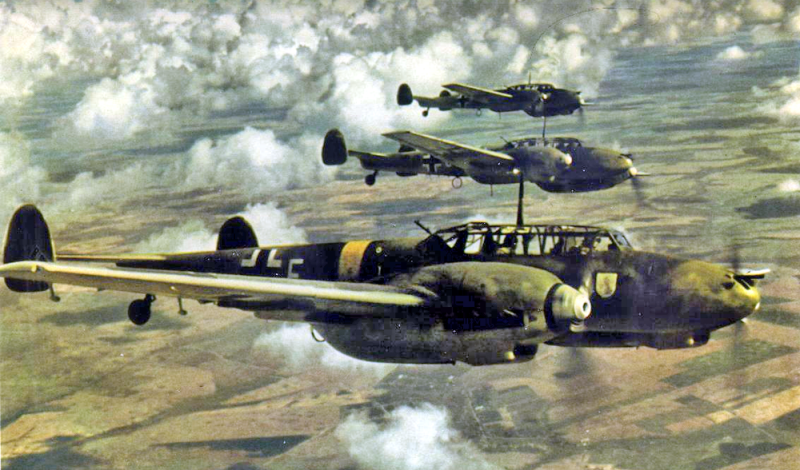
May 12, 1936 – The first flight of the Messerschmitt Bf 110 Zerstörer. The single-seat fighter had matured significantly during the Golden Age of Aviation in the 1930s, but a lack of adequate range was becoming the Achilles heel of fighters of the pre-WWII era. In an effort to make a warplane with greater range, designers began to consider twin-engine aircraft that could offer longer operational range along with the added benefit of greater firepower. When Adolf Hitler came to power in Germany in 1933, he already had his sights set on expanding German territory through the continuing goal of lebensraum. But to do that, he first had to rebuild Germany’s ground and air forces that had been dismantled by the harsh terms of the Treaty of Versailles which ended WWI. In 1935, Hermann Göring was appointed as the head of the fledgling Luftwaffe and became a vocal champion for the concept of the Kampfzerstörer (battle destroyer), a heavily armed aircraft that, theoretically at least, could smash through enemy fighter screens while also providing protection for larger bombers. Focke-Wulf, Henschel, Arado and Messerschmitt submitted prototypes for the new fighter-bomber and, even though designer Willy Messerschmitt omitted the internal bomb bay in order to increase range and speed, his design for the Bf 110 Zerstörer (Destroyer) was selected as the winner.

The Bf 110 wasn’t the most maneuverable aircraft (the Bf 110 is often erroneously referred to as the Me 110; “Bf” comes from Bayerische Flugzeugwerke, where Messerschmitt was chief designer), but its high speed allowed it to outpace the Messerschmitt Bf 109 fighter in service at the time. At first, the Zerstörer was produced in three basic variants: the B-1, which was armed with four 7.92 mm MG 17 machine guns and two 20mm MG FF cannons; the B-2 reconnaissance version, which replaced the two cannons with cameras while keeping the machine guns; and the B-3, which served as a trainer, with the cannons removed to make way for more radio equipment. Though the Bf 110 was fast for its time, and had good range, Luftwaffe planners knew that its service days were numbered, given the rapid pace of aircraft development. Even as Bf 110s were taking part in the invasion of Poland at the outbreak of WWII in 1939, its successor, the Messerschmitt Me 210, was ready for flight. However, the Me 210 suffered from serious teething problems, particularly with its aerodynamics, and was never produced in significant numbers. The Bf 110 was forced to soldier on throughout the war, where its weaknesses quickly became apparent.
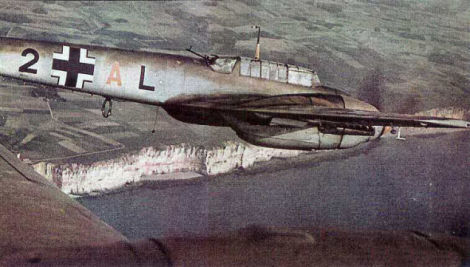
Though the Zerstörer served effectively in the Polish, Norwegian and French campaigns early in the war, the Battle of Britain showed that the Bf 110 was by no means a fighter, and it suffered bitterly as its pilots tried to protect German bombers attacking England. It was entirely unable to dogfight with the more agile Hawker Hurricane and Supermarine Spitfire, and its single defensive machine gun proved to be ineffective at fending off attackers. These weaknesses were mitigated by tactics such as diving on unsuspecting fighters from high altitude, but the Kampfzerstörer concept ultimately proved effective only on paper. On August 15, 1940, nearly 30 Bf 110s were lost in one day of combat, and 23 more were lost over the next two days. But even with its impending obsolescence, the Bf 110's days were not over.
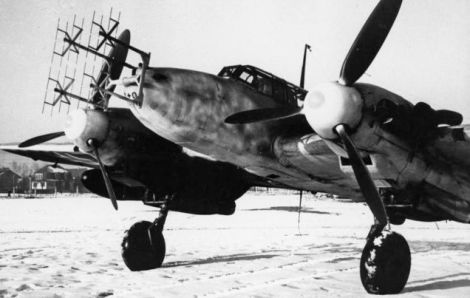
While it was eventually withdrawn from daylight fighting, the advent of the aerial Lichtenstein radar meant that the Bf 11o could now be turned into a potent night fighter, and it became the primary weapon of the German Nachtjagdgeschwader (night fighter wing) against British nighttime bombing raids. Some night-fighting 110s were armed with upward firing twin cannons, nicknamed Schrage Musik. Since the British bombers had no ventral turret, the 110s flew underneath the unsuspecting bombers and fired directly upward. In one instance, a Luftwaffe pilot dispatched four RAF bombers in just 30 minutes in this way. Though the Luftwaffe was ultimately unable to stop all the British bombers during their nighttime missions, radar-equipped Bf 110s exacted a heavy toll, with Germany’s top night fighter ace Major Heinz-Wolfgang Schnaufer claiming 121 victories with Nachtjagdgeschwader 1 and 4. In all, over 6,000 Bf 110s were produced, and while it never lived up to its original billing, the Zerstörer still played a vital role in the German Luftwaffe throughout the war in every theater of operations.
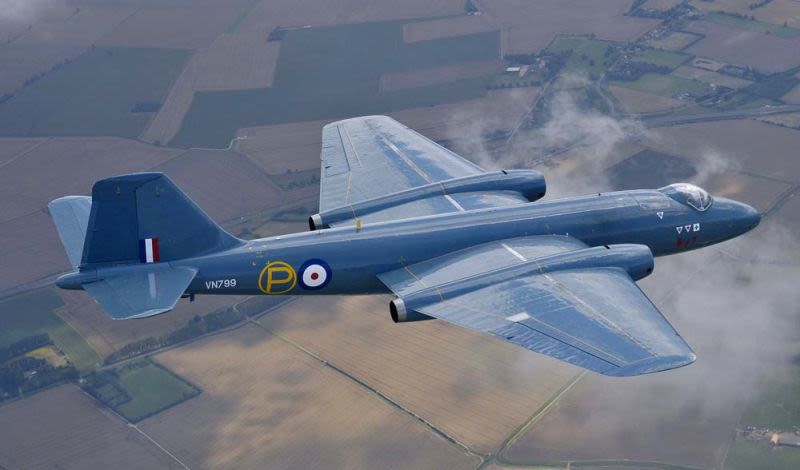
May 13, 1949 – The first flight of the English Electric Canberra. The history of aviation is marked by incredibly rapid technological development. Aircraft that were cutting edge technology when they took their first flight are often eclipsed by newer designs in only a few years, and some are obsolete the first time they turn a wheel or even before they come off the assembly line. But a handful of aircraft have proven to be so rugged, so reliable, and so adaptable to changing mission requirements that they reached and surpassed the remarkable milestone of 50 years of active service, and one of the aircraft on the list of diehards is the English Electric Canberra.
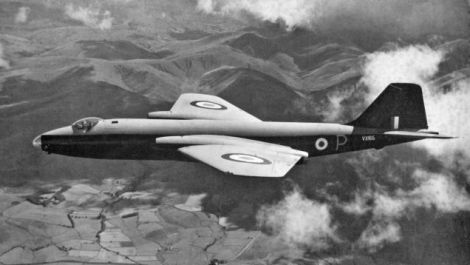
The Canberra arose from a British Air Ministry requirement for a bomber to replace the remarkable de Havilland Mosquito, a piston-powered, multi-role fighter bomber that served with great distinction during WWII. Though several well established manufacturers offered proposals, English Electric was named a finalist, even though they had a very sparse history of aircraft manufacture. Up to that point, their entire aircraft construction experience came from manufacturing the Handley Page Hampden and Halifax bombers, which they built under license during the war. But English Electric took cues from de Havilland and adopted the design ethos of the Mosquito: put the most powerful engines available into the lightest, most aerodynamic airframe you can design, and provide the greatest possible space for weaponry. With these principals in mind, English Electric designed an aerodynamically clean airframe with no fuselage protrusions, and powered the bomber with two Rolls-Royce Avon turbojet engines mounted in the broad wings. Though the designers considered swept wings, they chose instead to use wings that tapered outboard of the engine nacelles, since the Canberra’s mission requirements did not call for great speed. Maneuverability was considered of greater importance. In some regards, the Canberra actually resembled a scaled up Gloster Meteor, the first British jet fighter to enter production.
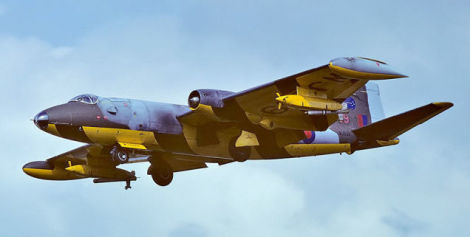
The Air Ministry ordered four prototypes, and by the time the first prototype took its maiden flight, orders had already been placed for 132 aircraft. Despite their lack of experience, English Electric produced an aircraft that was so easy to fly that new pilots required only 20 hours of jet training on the Meteor followed by a mere three hours of training in the dual-control Canberra trainer. The Canberra entered service with the Royal Air Force in 1951 and quickly showed its mettle. With a top speed of 580 mph, it was capable of outrunning contemporary jet fighters until the introduction of the Hawker Hunter. In a display of that great speed, a RAF Canberra won the “Last Great Air Race” in 1953 by covering the 12,300 mile distance from London to Christchurch, New Zealand in just under 24 hours, a record that still stands. Though the Canberra had been envisioned as a tactical nuclear bomber, early nuclear bombs were too large for it to carry, and early variants of the bomber suffered from relatively short range. Therefore, initial missions included tactical conventional bombing and reconnaissance. By 1957, changes in nuclear bomb design finally allowed the Canberra to take on the tactical nuclear attack mission, and bombers were stationed in Germany, Cyprus and Singapore to serve as a nuclear deterrent to the Soviet Union during the Cold War.
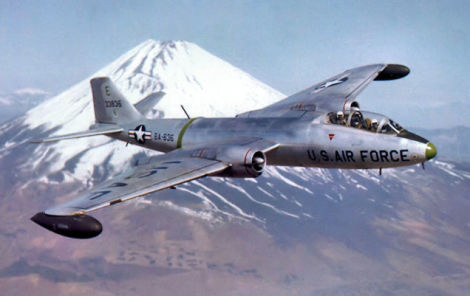
The Canberra also became a popular export aircraft, and when the US Air Force found themselves in dire need of a tactical bomber in Korea, they took the rare move of adopting the British-designed Canberra as the B-57 Canberra, with the Glenn L. Martin Company building and modifying just over 400 bombers. The B-57 earned the distinction of being the first American jet bomber to drop bombs in combat during missions over Vietnam in 1964. It also served extensively in the reconnaissance role. As a testament to the Canberra’s adaptability, and the reason for its longevity, no less than 27 variants were produced, plus seven variants developed by Martin. The Canberra has also proven to be an excellent research aircraft, and though the USAF retired their B-57s by 1983, NASA still operates three WB-57Fs for high-altitude research, earth science, and mapping missions. The Royal Air Force retired their last Canberras in 2006 after a remarkable service life of 59 years.

Short Takeoff
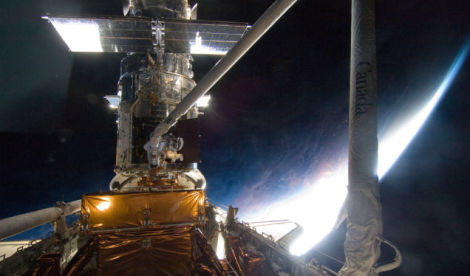
May 11, 2009 – The launch of Space Shuttle Atlantis on STS-125. When the Hubble Space Telescope (HST) was launched into Earth orbit in 1990, it was a landmark event that put a powerful telescope beyond the blurring effects of Earth’s atmosphere. Unfortunately, the HST had some significant flaws that hindered its capabilities, so a series of five servicing missions flown by the Space Shuttle that captured the telescope in orbit and effected repairs. STS-125 was the fifth and final Hubble servicing mission (named Servicing Mission 4, as there was a mission 3A and 3B). The crew of Atlantis installed a new data-handling unit, repaired the Advanced Camera for Surveys and Space Telescope Imaging Spectrograph, replaced the batteries, and also installed the Wide Field Camera 3 and Cosmic Origins Spectrograph, repairs that finally rendered the HST fully operational. The crew also installed the Soft Capture Rendezvous System which will allow future manned or robotic missions to safely dispose of Hubble when its mission is complete.
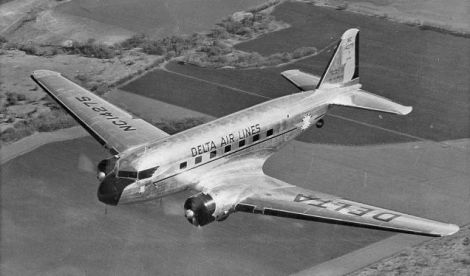
May 11, 1934 – The first flight of the Douglas DC-2, a twin-engine airliner that was developed by the Douglas Aircraft Company to compete with the Boeing 247. When rival airline United Aircraft and Transport Corporation (later United Airlines) monopolized the purchase of the 247, Transcontinental and Western Air (later TWA) sought their own all-metal monoplane airliner. Douglas responded with the DC-1, which was quickly developed into the DC-2 with more powerful engines and room for 14 passengers. The DC-2 proved successful, but was ultimately overshadowed by its successor, the DC-3, which became one of the greatest aircraft in history in both military and civilian service. Just under 200 DC-2s were built and operated by airlines and militaries around the world.
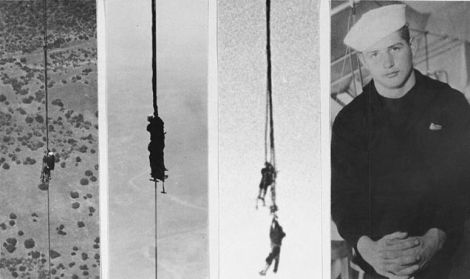
May 11, 1932 – The airship USS Akron takes members of the ground crew into the air in a landing accident. During an attempted landing at Camp Kearny in San Diego, a sudden gust of wind caused the USS Akron (ZRS-4) to rise suddenly, and the mooring lines were cut to avoid a potentially catastrophic nose stand. As Akron rapidly ascended, four inexperienced groundcrew members clung to a mooring line and were taken aloft. One quickly let go and fell roughly 15 feet, suffering a broken arm, while two others tried to hang on but ultimately fell to their death. The fourth, Seaman Apprentice Bud Cowart, managed to secure himself to the line and was eventually hoisted aboard the airship after an hour spent dangling beneath the airship. Newsreel footage captured the accident, along with the death of the two crewmen. The incident served as the inspiration for the first episode of the Adventures of Superman television program starring George Reeves as the red-caped superhero.
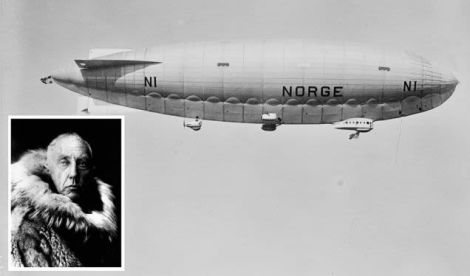
May 14, 1926 – Norwegian explorer Roald Amundsen completes the first airship flight over the North Pole. Amundsen headed a 16-man expedition to cross the North Pole flying an Italian-built semi-rigid airship named Norge. After leaving Spitzbergen, Norway on May 11, the team reached the North Pole at 01:25 (GMT) on May 12 and dropped Norwegian, American and Italian flags onto the polar ice below. They had planned to continue to Nome, Alaska, but a build up of ice on the propellers forced them to land in Teller, Alaska. While others, including Frederick Cook, Robert Peary, and Richard Byrd all claim to have reached the Pole before Amundsen, those claims remain subject to dispute. Only Amundsen’s flight has been officially verified.
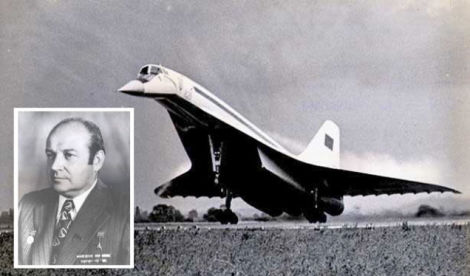
May 12, 2001 – The death of Alexei Tupolev. Tupolev was born in Moscow on May 20, 1925, the son of Andrei Tupolev, a pioneering aircraft designer and founder of the Tupolev Design Bureau. Alexei studied engineering at the Moscow Aviation Institute and slowly worked his way up through his father’s company. He became chief designer in 1963 and assumed control of the design bureau following his father’s death in 1972. Alexei’s work on the development of the Tu-104, the world’s first truly successful jet airliner, and his knowledge of jet propulsion led to his heading the design team working on the Tu-144 supersonic airliner starting in 1963. Alexei also worked on the Tu-160 supersonic bomber, and Buran, Russia’s attempt to build its own space shuttle.
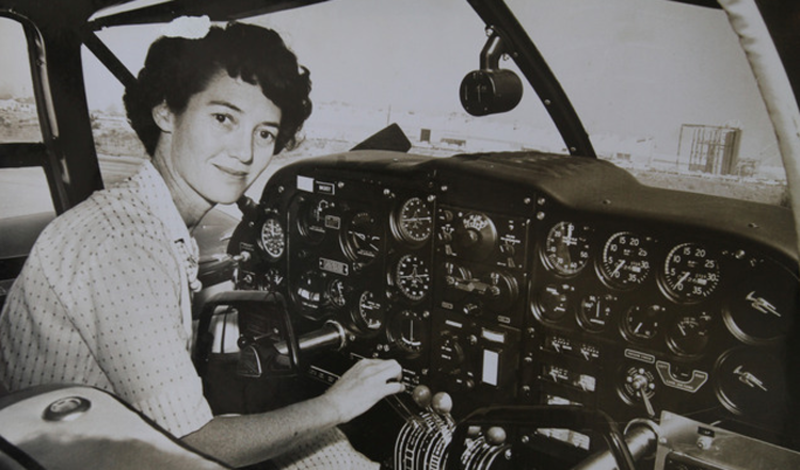
May 12, 1963 – Betty Miller becomes the first woman to fly solo across the Pacific Ocean. While many of the most famous record-breaking flights were carried out simply for notoriety or to prove that such a flight could be undertaken, Miller’s flight from California to Australia was made simply to deliver a Piper PA-23 Apache (N4315Y) to its new owner. Miller, Miller, a commercial pilot and flight instructor, set out on April 25 and flew from Oakland to Honolulu, Hawaii, a flight which took 17 hours. After waiting four days in Hawaii to repair the plane’s radio, she flew on to Canton Island in the Phoenix Islands, then Fiji, then Noumea, New Caledonia. She finally reached Eagle Farm Airport in Queensland, Australia on May 12 after covering 7,400 miles and spending 51 hours, 38 minutes in the air. For her feat of aviation, she received both the Federal Aviation Administration Gold Medal for Exceptional Service and the Harmon Trophy.

May 12, 1949 – The Soviet blockade of West Berlin ends. In the first major international crisis of the Cold War, the Soviet Union began a blockade of the city of Berlin on June 24, 1948 in an effort wrest control of the western sectors of the city from the Western allies. While the Soviets were able to block all land travel to the city, they could not halt air traffic, and the Allies began supplying the city by air in what came to be known as the Berlin Airlift. By the end of August 1948, 1,500 flights per day—one landing every minute—were delivering more than 5,000 tons of cargo, enough to keep the city fed and powered in spite of the blockade. On Easter Sunday 1949, cargo aircraft managed to deliver 13,000 tons of cargo, including the equivalent of 600 railroad cars of coal. The airlift continued for 11 months, making more than 189,000 flights totaling nearly 600,000 hours of flying and amassing more than 92 million miles flown. Faced with this herculean effort, the Soviets finally conceded and lifted the blockade at 12:01 am on May 12, 1949. West Berlin remained a free city, and it stood as an important symbol of the West’s resolve to fight the spread of Communism in Europe until the reunification of Germany in 1990.
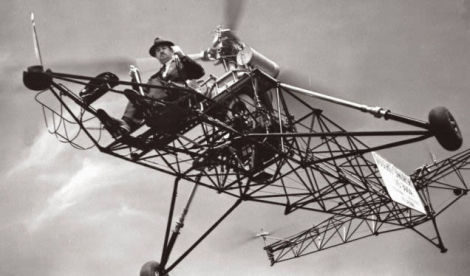
May 13, 1940 – The Sikorsky VS-300 makes its first untethered flight. Igor Sikorsky’s quest for a viable rotorcraft lead to the development of the VS-300 in 1938. However, Sikorsky had particular difficulty figuring out a system for cyclic control. So, as a safety measure, he undertook a series of tethered flights to work out the details of the control system. Once solved, Sikorsky untethered the helicopter and achieved completely controlled free flight. The VS-300 became the first single lifting-rotor helicopter in the US, and the first successful helicopter to use a single vertical tail rotor. The VS-300 was also the first to employ a single engine to power both rotors. The control system devised by Sikorsky is still in use today.
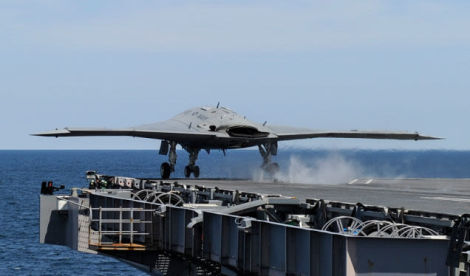
May 14, 2013 – The Northrop Grumman X-47B becomes the world’s first unmanned aircraft to launch from an aircraft carrier. In 2000, the US Navy committed to the development of an Unmanned Combat Air System (UCAS) and awarded contracts for demonstrator aircraft to Boeing and Northrop Grumman. Following its launch from the nuclear carrier USS George H.W. Bush (CVN 77), the X-47B performed the first autonomous touch-and-go landings three days later and the first arrested carrier landing on July 10 of that year. The X-47B later demonstrated autonomous aerial refueling in April of 2015. The X-47 program has finished, and the Navy is now focusing on the development of an autonomous Carrier-Based Aerial-Refueling System (CBARS) with delivery scheduled for 2021.
May 14, 2005 – Didier Delsalle lands a helicopter on the summit of Mt. Everest. Delsalle began his flying career in 1979 as a fighter pilot before transitioning to helicopters and working as a search and rescue pilot, and eventually became the chief test pilot for Eurocopter (now Airbus Helicopters). Flying a Eurocopter AS350 Écureuil (Squirrel), Delsalle touched down on the summit of Mt. Everest at an elevation of 29,029 feet, marking not just the highest elevation ever landed on but also the highest elevation possible on Earth. Delsalle repeated the feat the following day under more adverse conditions. The AS350 was only modified by the removal of seats to lighten the aircraft’s weight, and Delsalle reported that he discovered such strong updrafts that he barely needed any of the helicopter’s power to reach the summit.

May 14, 1973 – The launch of Skylab, the United States’ first orbiting space station. Skylab was launched from Kennedy Space Center atop a modified Saturn V rocket and orbited Earth for six years. During that time, NASA sent three manned missions to the station, where the crews performed scientific experiments and made observations of the Earth and Sun. NASA originally intended to use the Space Shuttle, under development at the time, to boost Skylab to a higher orbit, refurbish it, and expand it to accommodate six to eight astronauts, thus extending Skylab’s mission for an additional five years. However, delays in the Shuttle program made that impossible, and Skylab re-entered the atmosphere and disintegrated over the Pacific Ocean and western Australia in 1979.
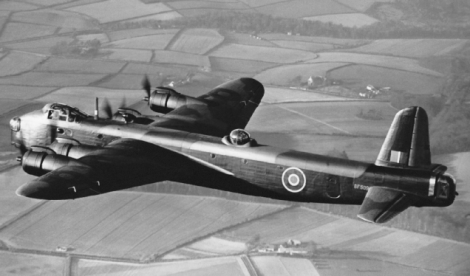
May 14, 1939 – The first flight of the Short Stirling, a heavy bomber developed for the RAF and the first four-engine heavy bomber of WWII. The Stirling entered service in 1941 and was capable of carrying an enormous 14,000-pound bomb load. It was also larger than both the four-engine Handley Page Halifax and the Avro Lancaster, the bombers that were designed to replace it. However, both of those aircraft were modified from twin-engine aircraft, while the Stirling was conceived with four engines from the outset. The Stirling’s service life was relatively short, and it was withdrawn from frontline duties by 1943. Following its withdrawal, it was used primarily for mine laying, and also played a significant role in the D-Day invasion as a glider tug.
May 14, 1928 – Mickey Mouse makes his debut in the short animated film Plane Crazy. Though the animated short Steamboat Willie, which debuted in November of the same year, marked Mickey Mouse’s debut in talking pictures, Plane Crazy debuted six months earlier and marked the true debut of Walt Disney’s most famous character. A silent picture in the nascent era of the talkie, Plane Crazy failed to find a distributor, and was re-released on March 17, 1929 with a sound track, making it the fourth Mickey Mouse film after Steamboat Willie, The Gallopin’ Gaucho, and The Barn Dance.
Connecting Flights
If you enjoy these Aviation History posts, please let me know in the comments. And if you missed any of the past articles, you can find them all at Planelopnik History. You can also find more stories about aviation, aviators and airplane oddities at Wingspan.